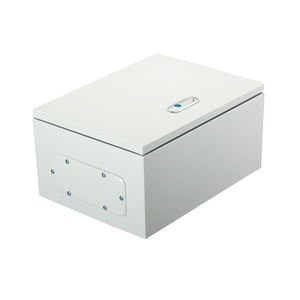
All categories
Featured selections
Trade Assurance
Buyer Central
Help Center
Get the app
Become a supplier

(1003 products available)





















Explosion-proof conduit boxes come in various types according to the nature of the installation environment. Common varieties include single outlets, multi-outlet, threaded, and non-threaded conduit boxes. Selecting a suitable type largely depends on the specific wiring requirements and the conditions of the workspace in question.
The materials used in an explosion-proof conduit box are crucial for its durability and functionality. Common materials include:
Aluminum Alloy
Lightweight and highly resistant to corrosion, aluminum alloy boxes are well-suited for use in harsh outdoor environments. Often, they possess excellent heat-dissipating features.
Stainless Steel
Further, known for its strength and resistance to corrosive substances, stainless steel is frequently deployed in chemical processing plants. It is highly durable and maintains its structural integrity over long periods.
Cast Iron
Cast iron boxes provide robust protection in heavy industrial environments. They withstand significant physical impacts and many adverse chemical elements. Their thickness and weight often lend to better protection than lighter materials.
Fiberglass Reinforced Plastic (FRP)
Plastic conduit boxes are an ideal choice for environments where metal corrosion is an issue. These boxes are lightweight and easy to install. Besides that, fiberglass-reinforced plastic models are very good at minimizing electromagnetic interference.
Valuable for ensuring safety and compliance within numerous industrial sectors, explosion-proof conduit boxes have broad application. In addition, their utility goes beyond mere protection from explosive risks.
Oil and Gas Industry
Often used in both the oil and gas industry, especially in refineries and drilling sites. Here, they house and protect wiring and electrical components used in extraction.
Chemical Manufacturing
The risk of explosion from chemical reactions or the volatility of stored products necessitates such high safety standards in a chemical plant. These boxes, therefore, become critical elements in securing wiring and electrical devices in environments where highly flammable substances are used.
Mining Operations
As many electrical systems in underground or open-pit mining may be subjected to explosive gases or dust, explosion-proof boxes find many applications in this line. Increasing safety prevents potential disasters and protects long-term investments.
Pharmaceutical Industry
Further, highly valuable electronic and electrical items in this space also ensure safety in the sensitive environment of the pharmaceutical industry. They help maintain the integrity of electrical systems used in drug manufacturing and storage.
Agriculture
The ability of these boxes to protect electrical equipment from hazards common in this industry, such as dust, gas, and moisture, allows them to be fitted into various agricultural production facilities.
Cost Savings
Preventing explosions and associated damage saves substantial costs in medical bills, legal fees, and equipment replacement. Thus, investing in such an explosion-proof conduit box pays for itself by reducing potential risks.
Regulatory Compliance
Since these boxes meet international safety standards, companies ensure their compliance and thus avoid expensive fines, further underpinning their commercial value.
Assess the Environment
One must consider the atmosphere where the explosion-proof conduit box will be installed. Usually, identify the types of gases, vapors, or dust present and their associated explosion classification. Manufacturers provide different conduit boxes rated for various explosion classes.
Material Selection
The box's material should be resistant to corrosion in the environment conducted. For example, chemical plants may require a stainless steel or aluminum alloy box, while a fiberglass reinforced plastic one might better suit outdoor environments.
Sizing and Configuration
The physical size of the box must accommodate all required conduit connections and wiring. A larger or smaller box can be problematic in terms potential overfilling or not having enough space for components.
Conduit Compatibility
The conduit box and the conduit must match in terms of size and type. This means one should select boxes compatible with both threaded and non-threaded conduit to maintain a secure connection without causing accidents.
Certifications and Standards
Certifications like the National Electric Code (NEC) or the International Electrotechnical Commission (IEC) will help ensure safety. Such certification means safety and regulatory compliance have been given priority.
Maintenance and Accessibility
It would be prudent to consider how easy it will be to access the electrical components within the box. Additionally, options that require minimal upkeep are very viable in most industrial settings.
The explosion-proof conduit boxes, as their name suggests, are designed to contain explosions originated from within itself. It then cools the escaping gases to a point where they no longer pose a threat. That is its interior is built to withstand internal explosions, and its exterior is designed to prevent ignition of the atmosphere outside. This means that a box in a hazardous area will prevent explosions from escaping to such areas.
The most common applications of explosion-proof conduit cover are in oil and gas, chemical manufacturing, mining, and the pharmaceutical and agriculture industries. In any industry that deals with flammable gases, vapors, or dust, these boxes are crucial for safeguarding electrical systems.
These boxes can be made of cast iron, stainless steel, aluminum alloys, or fiberglass-reinforced plastic. Each material comes with its own benefits. Stainless steel, for example, is very durable and resistant to corrosion. At the same time, aluminum alloy is lightweight. Meanwhile, fiberglass-reinforced plastic provides electrical insulation.
To determine how to choose one, one needs to assess the environmental conditions at their facility. They should also consider the specific explosive substances they encounter. They then must match these elements with a box rated for that particular explosive risk. Plus, ensure that the box is made of material suited for the given environment. Don't forget to verify that the box has relevant certifications.
These boxes are rugged and built to require minimal maintenance. Genuinely, the maintenance that is required for them is periodic inspections. These inspections help identify signs of wear or corrosion, which could compromise the box in the near future.